Posts Tagged: Small farm program
California drought and the fate of the state’s beloved berries

To find out, farm advisors around the state are comparing strawberries, blueberries and blackberries grown under four irrigation regimes – one that reflects the normal practice, one half the normal amount of water, one 75 percent of normal, and one that is 25 percent more than normal. The studies are being conducted in Santa Clara, San Luis Obispo, San Diego and Fresno counties.
“We’re doing this because of the water issue in California,” said Richard Molinar, UC Cooperative Extension advisor in Fresno County. “We’re in drought mode. We want to look at ways farmers can cut back the amount of water they are using and still have good tasting berries.”
Molinar recently brought samples of strawberries grown at the UC Kearney Agricultural Research and Extension Center in Parlier to the Vineyard Farmers Market in Fresno and invited patrons to share their preferences. Strawberry tasters were asked to evaluate the fruits’ appearance, flavor and texture. The advisors will aggregate information from taste testing done on berries from all the research sites.
The research will go beyond consumers’ preferences. Beth Mitcham, UCCE specialist in the Department of Plant Sciences at UC Davis, will evaluate the fruit grown under different irrigation regimes in the laboratory. Mitcham’s research will determine the amount of sugar, the sugar-acid ratio and the amount of antioxidants in the fruit and how these are affected by increasing or decreasing the usual amount of irrigation water.
The study is funded with a specialty crops grant from the California Department of Food and Agriculture awarded to the small farm program under the direction of Shermain Hardesty, UC Cooperative Extension specialist in the Department of Agricultural and Resource Economics at UC Davis.
See video of the strawberry tasting here:
Investing in food values: Slow Money founder to speak in Davis

The talk, along with introductions, Q&A and light refreshments, will be 4 – 6 p.m. at the Rominger West Winery, 4602 Second St. in Davis. Tickets are $10, and reservations are available online at http://ucanr.org/slowmoney.
Slow Money is a national network dedicated to investing in local food and agricultural enterprises.
“We often hear about ‘voting with your dollar’ when it comes to supporting small-scale farmers and local food,” said Shermain Hardesty, Cooperative Extension economist in the UC Davis Department of Agricultural and Resources Economics. “Shopping at a farmers market or becoming a CSA member are ways to support small-scale farms as a consumer, but Slow Money can be a way to invest in them.”
One local venture which has sought funding through Slow Money is the Capay Valley Farm Shop, a collaborative of 30 farms and ranches who together offer a CSA to institutions and corporations.
“Through Slow Money, we’re reaching investors who share our values, who believe that community food systems are a great investment for the health of communities and for the planet,” said Thomas Nelson, president of Capay Valley Farm Shop.
After presenting at an entrepreneur showcase this summer, the Capay Valley Farm Shop is working with a group of interested investors through Slow Money.
Another agricultural venture, Soul Food Farm in Vacaville, has also worked with Slow Money investors, receiving approximately $40,000 in loans.
“This model is another way that entrepreneurs in sustainable agriculture and community food systems can seek funding—especially when conventional sources such as venture capital, the Farm Credit System or commercial banks may not be an option,” Hardesty said.
The event will include a brief introduction to current UC Davis research on values-based food systems by Hardesty and Gail Feenstra, of the Agricultural Sustainability Institute. Values-based food systems create relationships between growers, funders, distributors, consumers and others based on shared values. Their project is working to identify bottlenecks—including access to capital—in the development of these values-based food supply chains, with an eye toward the enhancing the prosperity of smaller producers through networks that support environmental and social sustainability. This research is part of a USDA-funded, multi-state project, along with researchers at Colorado State University and Portland State University.
The event is sponsored by the Davis Food Co-op, Sacramento Natural Foods Co-op and the Giannini Foundation.
More details and ticket reservations for this event are available at http://ucanr.org/slowmoney.
You should taste it fresh
Question: What exotic fruit has been named as a flavor in Starburst candy, Ice Breakers gum, SoBe beverages, Vitamin Water drinks, Bacardi rum and even Axe body spray?
Answer: Dragon fruit. (Hylocereus spp.)
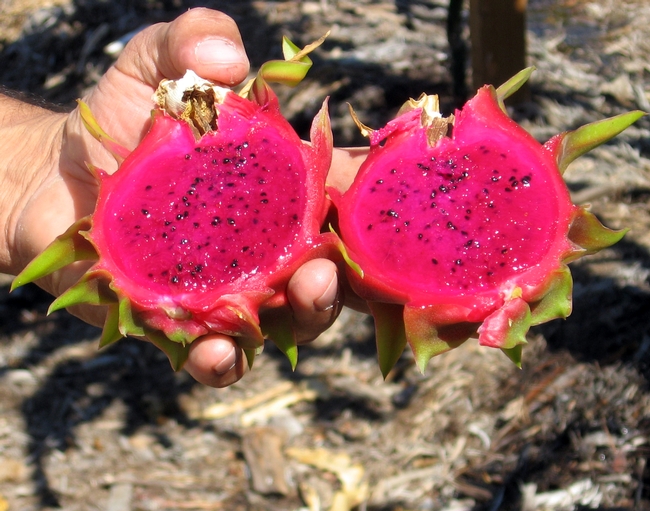
If you want to try one, you may be in luck because now is the peak harvest season in Southern California for this subtropical cactus fruit with the fire-breathing name — also known as pitahaya. And it just so happens that growing and eating fresh dragon fruit is what Ramiro Lobo, UC Cooperative Extension farm advisor for San Diego County and the Small Farm Program, is most interested in.
Lobo says he’s known about pitahaya since he was a kid, but his professional interest was rekindled when the enthusiasm of the Rare Fruit Growers group intersected with an ongoing quest to find crops that are more water-efficient for the region.
“Wherever you can grow Hass avocados, you can grow dragon fruit,” he said. “And it uses less water than avocados or any other orchard crop that we grow in San Diego.”
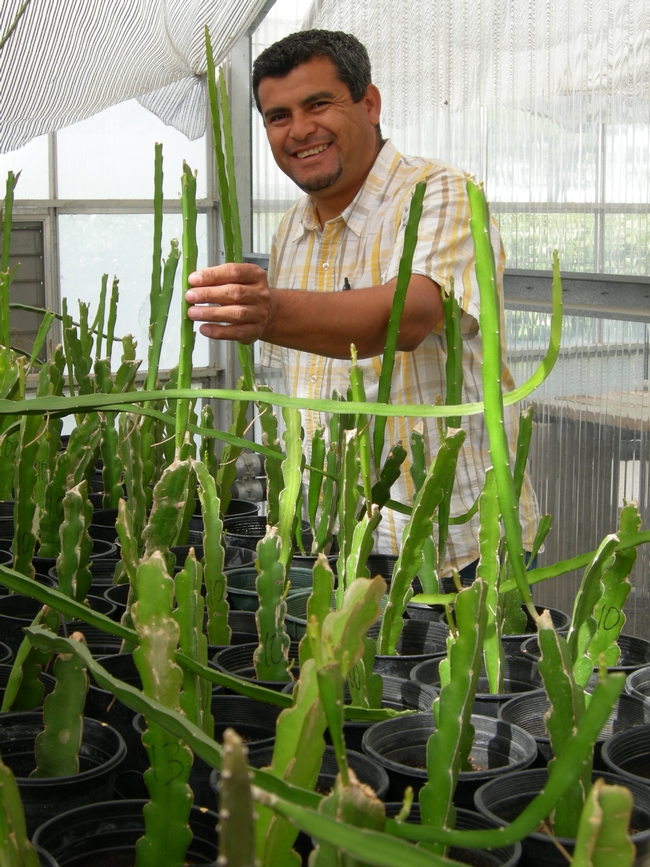
“We’ve seen the market expanding. We’re seeing it in high-end restaurants in Los Angeles and Las Vegas,” he said. “Supply is very sketchy right now, but growers who are selling direct at farmers markets are getting $7-8 per pound. Hardly any other fruit today is bringing that kind of money.”
One other clue that the U.S. market for this “artichoke from Mars” (as one LA Times writer described it) is expanding? Imports of the fruit have been growing from Vietnam, with perhaps 600 tons imported in 2010. And the USDA is currently working through the processes that could allow imports from Mexico, Thailand and Central America too.
While Lobo doesn’t sound too worried about competing with imported dragon fruit, he does hope your first taste of fresh dragon fruit is indeed very fresh.
“We cannot compete with Vietnam fruit for price, but we can definitely compete for quality,” he said. “The challenge is that a lot of people are exposed to dragon fruit, but the fruit quality is lousy. It’s a very sensitive fruit, so if you put it in a container and send it across the ocean for 10 days, it’s not going to be as good. But people who get exposed to a good variety keep buying it.”
In California, it is estimated that about 200 acres are planted in pitahaya, with anywhere from 400 to 1,000 acres planted nationwide.
Lobo oversees approximately 500 dragon fruit plants at the UC South Coast Research and Extension Center in Irvine. He is currently working to set up an irrigation trial for pitahaya, to better evaluate its water requirements. He is also working to test out different trellis systems, comparing hedge versus orchard systems for this fruiting cactus.
The UC South Coast Research and Extension Center is also where the pitahaya field day was held recently. Lobo said questions from the day’s 100 or so participants sounded like more growers are getting serious about growing pitahaya commercially, with more technical questions and an interest in disease, rodent and pest management.
“The bar has been raised, and [some of those questions] even put us in a bind because without the research, it is kind of hard to answer them,” he said.
In the meantime, Californians and marketing companies will probably continue to find new secondary uses for this fruit’s juice, pulp and name: Lobo says he’s seen wines made with dragon fruit and organic yarn dyed naturally with that fiery pink flesh.
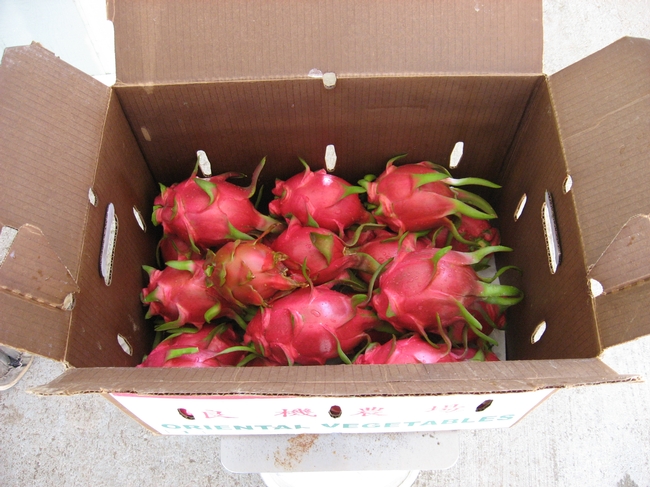
Pitahayas, as packed at a small farm in San Diego. (Photo by Shermain Hardesty)
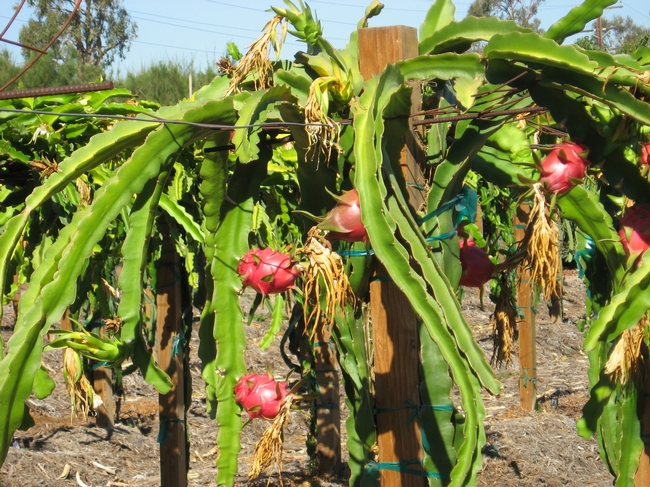
At UC South Coast Research and Extension Center, the dragon fruit plants are currently in an orchard system, though new trellis trials will soon be under way. (Photo by Shermain Hardesty)
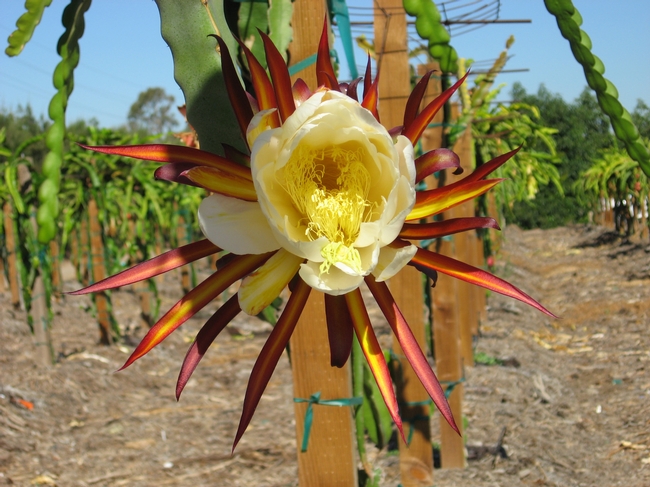
Pitahaya blooms at UC South Coast Research and Extension Center. (Photo by Shermain Hardesty)
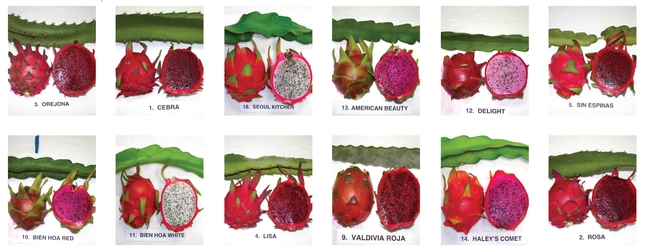
Colors of ripe pitahaya flesh can vary between red, fuschia, pink and white.
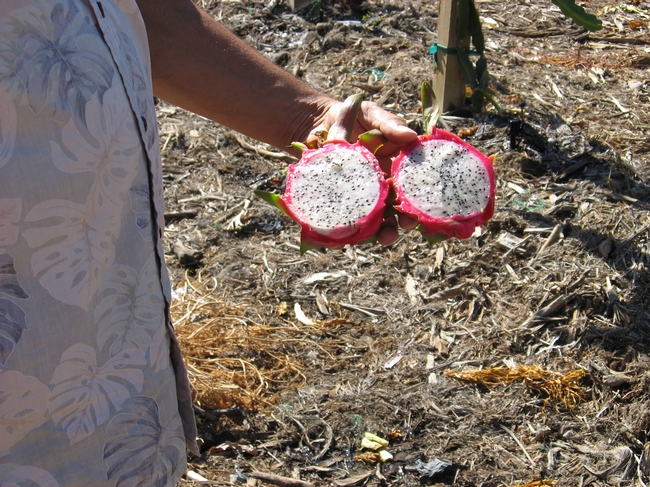
Irvine Field Station white flesh pitahaya
Put down that zucchini! Pick up the ... bittermelon?
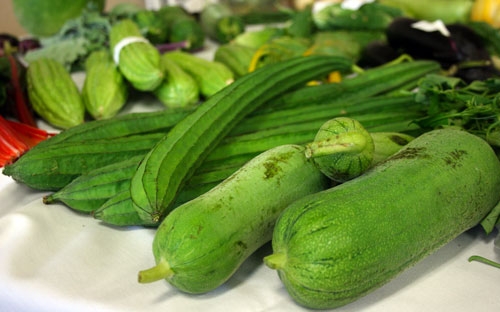
Welcome to August. Are you tired of summer squash yet?
If your dinners have been overflowing with zucchini recently (like mine have), now might be a great time to try new varieties of otherwise familiar vegetables.
One of the farm advisors I work with has long touted some varieties of "Asian vegetables" as more flavorful than their traditionally "American" cousins. Here in the U.S., vegetable varieties like these are more likely to be grown by farmers — and sold to customers — who have close ties to Asian immigrant communities. Richard Molinar, UC Cooperative Extension farm advisor for Fresno County, works frequently with Hmong farmers and says that he now prefers Hmong cucumber and Japanese eggplant to the varieties you might find in most California supermarkets.
After years of hearing Molinar's claims, I finally had a chance to try some of these new-to-me Asian vegetables during lunch at the Hmong Specialty Crops and Medicinal Herbs conference.
Presenters in the morning talked about crops such as sinqua, luffa (photo above has fresh luffa, in angled and smooth varieties), moqua, snake gourd, bittermelon and donqua — all of which are cucurbits, in the gourd family with other squashes and melons. Other Asian vegetables common in some specialty markets include leafy greens and tender shoots from chayote, amaranth, bittermelon, pumpkin, okra leaf, yam leaf, yucca and sour leaf plants. Discussions at the conference focused on these and other specialty crops, including ways to eat them.
"Maybe we need a recipe to teach customers how to buy these new crops," said Chukuo Thao, CEO of National Hmong American Farmers, who alternated between English and Hmong while speaking at the conference.
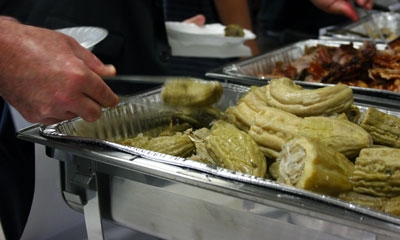
Some of the vegetables and herbs discussed at the conference were highlights of that day's lunch. The menu included a slushy Hmong cucumber drink, purple sticky rice, salsa made with cherry tomatoes, stir-fried mustard greens with pork skin, Hmong herbal chicken soup and steamed bittermelon stuffed with turkey.
But how did it taste? The stuffed bittermelon was what I was most looking forward to trying. The dish was delicious and wow, was it bitter! That is one appropriately named vegetable. Speakers at the conference suggested bitterness is frequently associated with medicinal qualities in Hmong cuisine.
Not all of the lunch dishes were bitter, of course. The cucumber dish was refreshing and very sweet, a dish with eggplant was spicy, and the mustard greens were salty and pungent. Many of the dishes were also made with lemongrass; Fresno County is where most of the nation's lemongrass comes from, according to Molinar in a recent article from the California Ag Network.
Curious about other Asian vegetables? Check out the Small Farm Program's guides to Asian vegetables, along with tips for farmers about how to grow and sell these niche varieties.
Question: The Small Farm Program has a lot of information about different vegetable varieties, but I'm still finding new vegetables to try. What are some of your favorite Asian vegetables?
P.S. While the conference was my first chance to taste bittermelon, Richard Molinar and Gus Schumacher (former USDA undersecretary) were being honored by Hmong community members for their long-time support of Southeast Asian refugee farmers. The two men were each given Hmong names in a special ceremony.
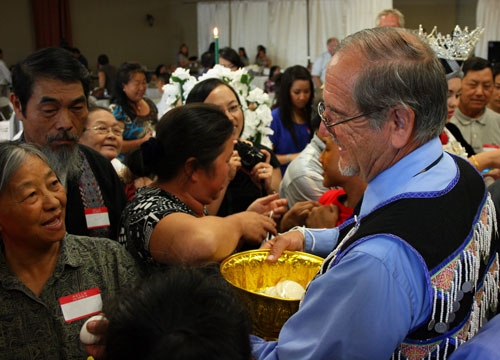
Looking for a farm or ranch experience?
This weekend, you're in luck. You can bring your favorite children to Kids Day on the Farm in San Luis Obispo County to churn butter, plant sunflowers, press cider, make a cornhusk doll and lots more. You can learn draft horse driving, go on a calf feeding tour, and enjoy bluegrass music at the Heartland Festival in Merced County, take a bus tour from Berkeley to pick peaches at Frog Hollow Farm in Brentwood, shop for apple butter at the Gravenstein Apple Fair in Sebastopol, or hike to the top of the hill to see great views of San Francisco Bay on a Petaluma organic farm.
or you can use the calendar to find special events. The website is getting more popular every week since we worked with the ANR communications team to add the calendar and the UC Food Blog to keep it looking fresh for visitors searching for adventure and education.
If you are a working farmer or rancher operating an agritourism business or organizing agritourism events, we invite you to complete the directory application or the event listing application online so we can include your business and events in the directory. The listings and event postings are always free. You can also include a picture with your event posting.
With more than eighty-five percent of Californians living in cities of at least one million people, most of us don't know the people who grow and raise our food, and most of us don't get many chances to visit farms or ranches. A growing number of farmers and ranchers are opening their land to visitors by starting enterprises that offer urban and suburban people a chance to experience agricultural life.
These agritourism operations serve the triple purposes of bringing additional revenue to the growers, building connections between urban and rural communities, and giving the producers the chance to sell farm products directly to the public right at the farm. An apple pie bought straight from the apple ranch pie shop will just taste better than one bought in town!
Agritourism is a growing business in California. Farmers and ranchers who would like more information about starting agritourism enterprises may be interested in the agritourism section of the Small Farm Program website, and may want to subscribe to the AgTour Connections newsletter.
Have a great weekend out of town!

